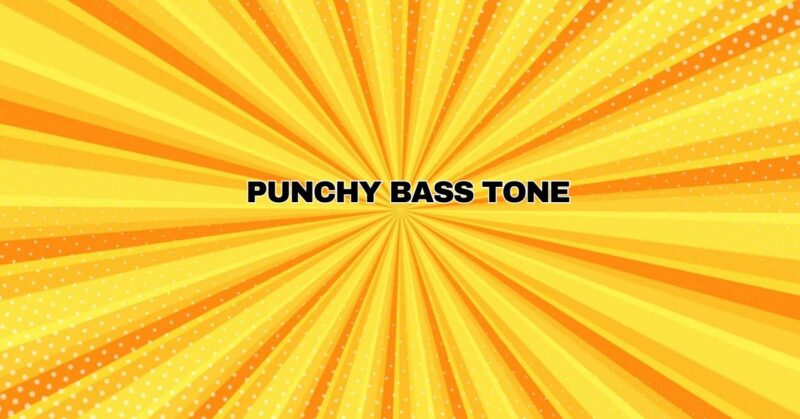Bass, often referred to as the heartbeat of music, is a fundamental component that gives a track its groove, depth, and power. Achieving a punchy bass tone is essential for creating music that not only sounds great but also compels listeners to move and groove. Whether you’re a bassist, a music producer, or a sound engineer, this comprehensive guide will help you understand and master the art of crafting the perfect punchy bass tone.
Understanding Punchy Bass Tone
A punchy bass tone is characterized by its clarity, impact, and tightness. It’s the kind of bass that cuts through the mix, providing a solid foundation for the entire track. Here are the key elements that contribute to punchy bass tone:
1. Attack:
The attack is the initial part of the bass note that provides definition and punch. A punchy bass tone typically has a well-defined and sharp attack that gives it the desired impact.
2. Sustain:
Sustain is the duration for which a bass note lingers after the initial attack. Punchy bass tones often have a balanced sustain, neither too short nor too long, allowing each note to stand out while maintaining the overall groove.
3. Clarity:
Clarity refers to the ability to hear each note distinctly, even in complex basslines. A punchy bass tone is clear and doesn’t get lost in the mix.
4. Tightness:
Tightness indicates how well the bass locks in with the rhythm section. In a punchy bass tone, the notes are tightly controlled, ensuring that they sit perfectly in the pocket and contribute to the overall groove.
5. Presence:
Presence refers to the bass’s ability to be felt and heard across different playback systems, from small headphones to massive subwoofers. A punchy bass tone has a strong presence that translates well on various platforms.
Now, let’s delve into the techniques and considerations for achieving the ideal punchy bass tone:
Bass Guitar Techniques:
1. Use of Fingers vs. Pick:
The choice between playing with your fingers or using a pick can significantly impact your bass tone. Fingers tend to produce a warmer and smoother sound, while a pick can add attack and punch.
2. Right-Hand Positioning:
Where you pluck the strings with your fingers can influence the tone. Plucking closer to the bridge produces a brighter and punchier sound, while plucking closer to the neck results in a mellower tone.
3. Technique and Dynamics:
Pay attention to your playing technique and dynamics. Varying your attack and finger pressure can create dynamics in your bassline, adding to its punch and expressiveness.
Bass Guitar Setup:
1. String Choice:
The choice of bass strings affects the tone significantly. Roundwound strings tend to provide more brightness and punch, while flatwound strings offer a smoother, more vintage tone.
2. Action and Setup:
Ensure that your bass is set up correctly with the right action height. Lower action can facilitate faster playing and enhance punch, but it should be balanced to prevent fret buzz.
3. Pickup Selection:
Experiment with different pickup configurations if your bass allows it. Different pickups emphasize different tonal qualities, and finding the right combination can enhance punch.
Amp and Effects:
1. Amplifier Selection:
The choice of bass amplifier can significantly impact your tone. Tube amplifiers often provide warmth and punch, while solid-state amps may offer more clarity and precision.
2. Equalization (EQ):
Use the EQ on your bass amplifier or in your DAW to shape your bass tone. Boosting the midrange frequencies can add punch, while scooping the mids can give a more modern, aggressive sound.
3. Compression:
Compression can be a powerful tool for achieving punchy bass. It evens out the dynamic range, ensuring that each note has consistent volume and presence.
4. Overdrive and Distortion:
Light overdrive or distortion can add grit and attack to your bass tone, enhancing its punchiness. Use these effects sparingly to maintain clarity.
Mixing and Post-Processing:
1. Layering:
In mixing, consider layering multiple bass tracks with different tonal characteristics to create a fuller and punchier sound.
2. Parallel Compression:
Apply parallel compression to your bass track to emphasize the attack and punch while maintaining the natural dynamics.
3. Sidechain Compression:
Use sidechain compression to create space for the kick drum in the mix. This technique can help both the kick and bass stand out, contributing to punchiness.
4. Saturation and Harmonic Exciters:
Saturation and harmonic exciters can add harmonics and warmth to your bass, making it sound more aggressive and punchy.
Monitoring and Room Acoustics:
1. High-Quality Monitors or Headphones:
Ensure that you’re using high-quality studio monitors or headphones to accurately hear and evaluate your bass tone.
2. Room Treatment:
If you have a studio or recording space, consider room treatment to control acoustic reflections and resonances, which can impact your perception of bass.
Conclusion:
Crafting the perfect punchy bass tone is both an art and a science. It involves a combination of playing technique, equipment selection, setup, and post-processing. It’s important to remember that there’s no one-size-fits-all approach, as the ideal punchy bass tone can vary depending on musical genre, personal style, and artistic intent. Experimentation and continuous learning are key to mastering this essential aspect of music production and bass performance. By honing your skills and applying the techniques outlined in this guide, you’ll be well on your way to creating basslines that make listeners feel the groove and rhythm at their core.


